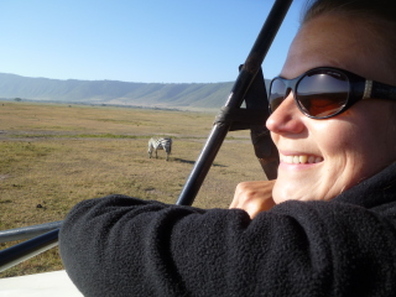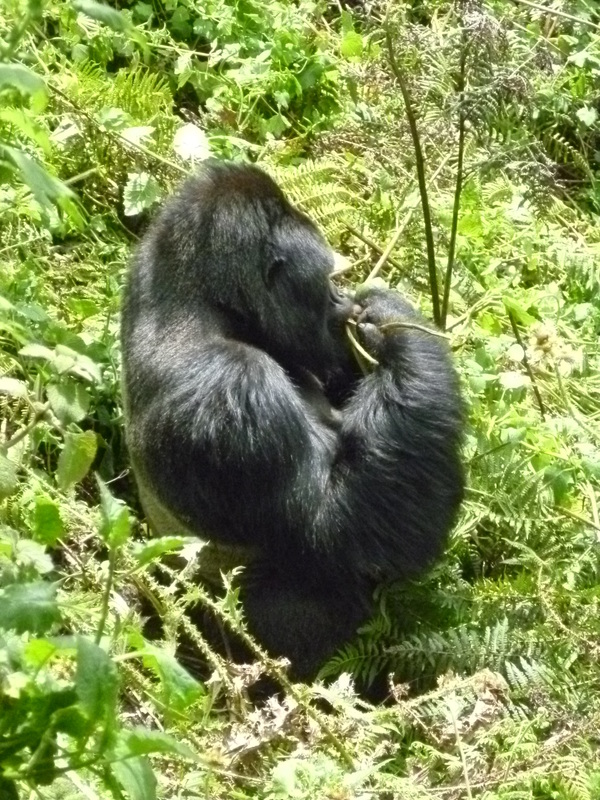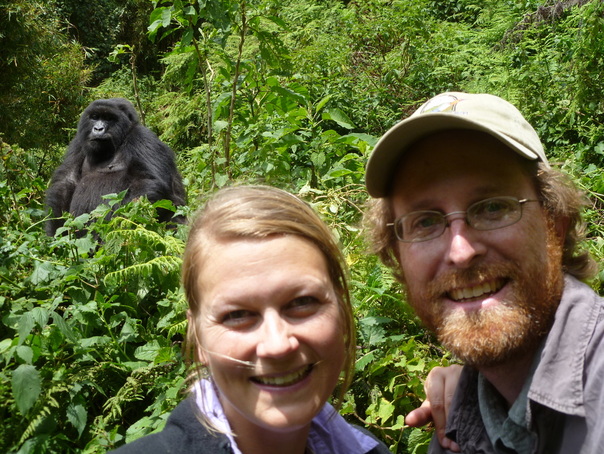|
A few days ago Mike and I took a camping safari through Tanzania’s Serengeti National Park and Ngorongoro Crater. Along with us in the Land Rover were a guide/driver, a cook, and three other travelers, including an Irishman named Michael who was severely visually impaired. He is not blind, but he cannot see the faces of people standing right in front of him. His girlfriend, Fionnoula, told me later that he had come along as a favor to her. What amazed both her and me was that on this safari, the wildlife was so close—just a few feet away at times—that Michael could actually see much of it well with the help of binoculars. When Michael couldn’t see something, like a flying flock of sacred ibis, he sometimes commented on how he could still hear their noisy call. This made me think about experiencing a safari through all the senses, not just vision. So here are five snippets of our trip through their sound, smell, touch, sight, and taste.  The squeaky sound of the grass as Cape buffalo pulled it from the ground and ate it in the middle of the night just outside our tent on the rim of the Ngorongoro Crater. The buffalos huffed through their noses as they chewed. The Cape buffalo is one of the most dangerous animals in Africa, known to gore even lions with its enormous horns. So we lay very, very still.  The smell of a pod of hippos wallowing in a pond. We could catch their stinky scent before we saw them. Let’s just say that they do more than just pee in the pool. Hippos themselves have a good sense of smell and hearing, but poor eyesight. I will not be wearing Eau de Hippo anytime soon.  The feeling of the hot wind and sunshine on my face as I stood up and looked out of the roof hatch while we drove across the Serengeti. The word Serengeti is derived from the Maasai language and means “endless plains.”  The sight of two lionesses and three cubs resting on the road directly in front of us around dusk. We skidded to a stop. Then we learned that we had a flat tire and had to get out of the vehicle directly in front of the lions. While we nervously watched these wild cats disappear into the grass as the sun set, our guide and cook fixed the car.  Celebrating the end of our safari with Daniel Mengoriki, left, and another new friend, Laurence Masawe, far right. The smoky, savory taste of nyama choma, or barbecued beef, which we had back in the city of Arusha with our new friend Daniel Mengoriki and his cousin Evans. The beef is served in small slices on a plate with little piles of sea salt on the rim. You eat it with your right hand, along with a little ball of sticky ugali, a doughy staple made from cornmeal and hot water. All best washed down with a cold Serengeti beer.
1 Comment
The silverback gorilla I encountered was a lady’s man. His family—one of seven habituated gorilla groups in Rwanda’s Parc National des Volcans—is called Hirwa, a Kinyarwanda word that means “lucky.” The group is named after the success of the dominant male, Munyinya, who has battled silverbacks in three other groups and succeeded in convincing a female from each one to join him in his own territory. Now they are 16: the silverback, five females, five juveniles, and five babies, including a set of twins named Isangano ("meeting place") and Isango ("appointment").
To reach the group, we had to hike partway up the Sabinyo Volcano, which had the steepest slope I’ve climbed since Half Dome in Yosemite National Park. We—our trekking group of eight, plus a guide, a porter, and an armed guide—pulled ourselves up using vertical stalks of bamboo and jungle vines. It took about two hot hours before we finally reached the group of trackers who had already located the gorillas. I was at the front by the guide, so I was the first to see a large, black, crinkled face. It quickly disappeared. The gorillas were in a ravine filled with their favored food, a celery-like stalk called Peucedanum linderi (which was very bitter but refreshingly watery when I tried it myself), and thorny trees, stinging nettles, and tangled briar. We had to climb on top of it all, since it was impossible to walk through, which had us sliding over green mattresses of jungle. When we landed on solid ground again, we were surrounded by gorillas. The silverback, Munyinya, was as enormous as an NFL linebacker times two. He kept his back turned toward us and made low rumbling sounds, which our guide, Oliver, returned. Oliver said the rumble means, “Everything’s OK.” I was filled with a sort of whipped wonder, which made my chest feel airy, buoyant. Just five feet to my left was a large mother with her two tiny twins clinging to her back, looking at us with wide eyes. Then another female ambled down a slope directly toward me. I stepped back, but she just kept coming, paying no attention to me. She brushed past my pant leg and headed down the hill. Further off, youngsters swung on one arm from tree branches. One fell down and somersaulted through the bush in a black hairy ball. We continued to slip, slide, and crunch our way down the ravine, following the silverback. I’d look in one direction, see a tall bush shaking, and then see the wrinkled face or round back of another gorilla. At times, one would look directly at us, so peacefully and non-challantly, not really caring that we were there. The hour we were there, the gorillas never seemed to stop eating. When Munyinya turned to the side, I could see him feeding four or five stalks into his mouth at once, like a combine. There was a juicy crunching sound and more low, satisfied grunts. Everything’s OK, he said. The first thing I noticed in Uganda’s Kibale National Forest Park was the abundance of butterflies. It looked like petals were falling all around us, a shaken bouquet of iridescent pale blue, lime green, lucid white, pink-spotted, bright yellow, and deep black wings. Everywhere they fluttered.
If a forest is home to so many different butterflies, I thought, what other marvelous, mysterious creatures live here? We had come to track Kibale’s most famous residents: chimpanzees! It’s hard to write chimpanzee without an exclamation point, they are so exciting. I never imagined that I would get to see them--humans’ closest genetic relatives, along with bonobos--in the wild. Yet my guidebook informed me that Kibale is one of the best places in the world to encounter them. Here, amid 351 species of trees and 12 other types of primates, a group of chimps has been habituated to human contact. An experienced tracker can find them about 90 percent of the time, and every day tourists get to spend one hour in their presence for a fee of $150 per person. Our guide was named Ronald. He is Ugandan and has been tracking chimps for 14 years. “They know me well,” he said. He led us up a red road into the park, and then he turned sharply left into the forest. Suddenly we were surrounded by tall trees, strangler figs twisting up trunks, vines cascading back to the earth. Everywhere it was green, but not so dense that we couldn’t make our way. We heard thunder rumbling. After about a half hour of hiking, Ronald turned around and said, “They are here.” We walked a few more steps, and only ten feet away a chimp was stretched out on the ground on its back, an arm hanging lazily above its head. It looked so relaxed, so languorous and at peace. It was taking an afternoon snooze. The chimp glanced in our direction and then looked away, not caring. It was the most beautiful thing to see this animal in the wild, so fully at ease. Several other chimps were in the distance, some sitting, some picking at leaves, some lying down. The alpha male sat not too far away, looking ominous. A tourist got too close and the male suddenly swung a branch in the air. She had violated his space, and he was demanding respect. This chief chimp moved deeper into the forest, and one by one the other chimps followed, using all four limbs, quickly and smoothly. We slowly walked after them, sometimes losing sight of their dark bodies in the shadows and thick of the jungle. Then we came upon a solitary chimp resting its back against a tree trunk, looking around slowly, quietly, meditatively. Perhaps somewhere way, way down the silly strings of this chimp’s DNA lies a genetic tie with Henry David Thoreau and his Walden. We belong in nature, too, I thought. Before our hour with the chimpanzees(!!) had ended, we reached the park’s “grasslands,” which was really a mass of vines and thorny branches tangled with tall stems. Ronald wanted to press on, to see the chimps one more time. “I must try,” he said. So we tumbled through a green vortex, with the jungle grabbing at our legs and arms, leaving us pin-cushioned with pokey seedpods. We were rewarded with an amazing view: a chimp crouched just a few feet away, employing his big strong arm and dexterous fingers to delicately pick something tasty off a plant. So much power used with so much grace. |
Archives
July 2012
Categories
All
|





 RSS Feed
RSS Feed